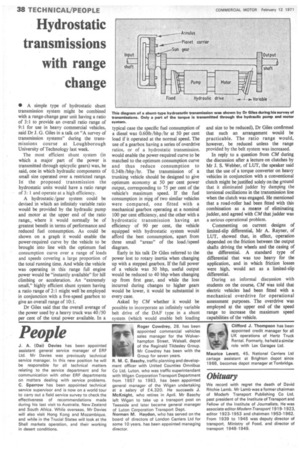Hydrostatic transmissions with range change
Page 40

If you've noticed an error in this article please click here to report it so we can fix it.
• A simple type of hydrostatic shunt transmission system might be combined with a range-change gear unit having a ratio of 3:1 to provide an overall ratio range of 9:1 for use in heavy commercial vehicles, said Dr J. G. Giles in a talk on "A survey of transmission systems" during the transmissions course at Loughborough University of Technology last week.
The most efficient shunt system (in which a major part of the power is transmitted through epicyclic gears) was, he said, one in which hydraulic components of small size operated over a restricted range. In the proposed transmission the hydrostatic units would have a ratio range of 3: 1 and operate at a high efficiency.
A hydrostatic /gear system could be devised in which an infinitely variable ratio would be provided by the hydraulic pump and motor at the upper end of the ratio range,, where it would normally be of greatest benefit in terms of performance and reduced fuel consumption. As could be shown on a graph it would enable the power-required curve by the vehicle to be brought into line with the optimum fuel consumption curve over a range of loads and speeds covering a large proportion of the total running time. And while the vehicle was operating in this range full engine power would be "instantly available" for hill climbing or acceleration. An "extremely small," highly efficient shunt system having a ratio range of 2:1 might well be employed in conjunction with a five-speed gearbox to give an overall range of 10:1.
Dr Giles said that the overall average of the power used by a heavy truck was 40/50 per cent of the total power available. In a typical case the specific fuel consumption of a diesel was 0.601b /bhp /hr at 50 per cent load if it operated at the normal speed. The use of a gearbox having a series of overdrive ratios, or of a hydrostatic transmission. would enable the power-required curve to be matched to the optimum consumption curve and thus reduce consumption to 0.34Ib /bhp /hr. The transmission of a trunking vehicle should be designed to give optimum economy at 50 per cent power output, corresponding to 75 per cent of the vehicle's maximum speed. If the fuel consumption in mpg of two similar vehicles were compared, one fitted with a mechanical gearbox operating at a nominal 100 per cent efficiency, and the other with a hydrostatic transmission having an efficiency of 90 per cent, the vehicle equipped with hydrostatic system would afford the best consumption, apart from three small "areas" of the load /speed diagram.
Early in his talk Dr Giles referred to the power lost to rotary inertia when changing up with a stepped gearbox. If the full power of a vehicle was 50 bhp, useful output would be reduced to 40 bhp when changing up from first gear, and while the loss incurred during changes to higher gears would be lower, it would be substantial in every case.
Asked by CM whether it would be possible to incorporate an infinitely variable belt drive of the OAF type in a shunt system (which would enable belt loading and size to be reduced), Dr Giles confirmed that such an arrangement would be practicable. The ratio range would, however, be reduced unless the range provided by the belt system was increased.
In reply to a question from CM during the discussion after a lecture on clutches by Mr J. S. Webber, of LUT, the speaker said that the use of a torque converter on heavy vehicles in conjunction with a conventional clutch might be justified solely on the ground that it eliminated judder by damping the torsional oscillations in the transmission line when the clutch was engaged. He mentioned that a road-roller had been fitted with this combination as a means of eliminating judder, and agreed with CM that judder was a serious operational problem.
Commenting on current designs of limited-slip differential, Mr A. Rayner, of LUT, showed that, in effect, operation depended on the friction between the output shafts driving the wheels and the casing of the differential. A standard type of differential that was too heavy for the application, and in which friction losses were high, would act as a limited-slip differential.
During an informal discussion with students on the course, CM was told that electric vehicles had been fitted with a mechanical overdrive for operational assessment purposes. The overdrive was employed at the upper end of the speed range to increase the maximum speed capabilities of the vehicle.
































































































